EFSA Recommends Improvements to Meat Inspection

The European Food Safety Authority (EFSA) has completed a major piece of work that will provide the scientific basis for the modernisation of meat inspection across the EU. Following a risk based approach, EFSA has identified and ranked public health hazards in meat. As requested by the European Commission, EFSA has recommended improvements to meat inspection procedures to protect consumers from risks related to such hazards.
EFSA’s executive director, Catherine Geslain-Lanéelle, says: “This work will support risk managers in mitigating public health risks at an important step in the meat production chain.”
The four scientific outputs published provide advice on meat inspection procedures in cattle, sheep and goats, farmed game, and domestic solipeds such as horses. These outputs follow two previous opinions on inspection of swine and poultry, published respectively in 2011 and 2012. Since then EFSA has assessed meat inspection procedures for a broad variety of meat-producing animals in the EU.
Traditional practices of meat inspection are not always suitable for detecting the main meat-borne hazards such as Campylobacter and Salmonella or contamination by chemical substances such as persistent organic pollutants or prohibited substances. For this reason, the European Commission decided that meat inspection practices in the EU should be modernised.
For all types of meat-producing animals considered, EFSA has identified foodborne biological and chemical hazards and ranked them according to their risk for public health.
For biological hazards, the priority ranking was based on assessment of their impact on incidence of disease, the severity of the disease in humans and evidence that consumption of meat from the various species is an important risk factor for the disease.
Risk ranking of chemical hazards was based on the outcomes of the National Residue Control Plans for 2005- 2010 and other testing programmes as well as substance-specific criteria, such as its toxicological profile.
For the most relevant foodborne biological hazards, EFSA has also proposed harmonised epidemiological indicators. The indicators will be useful in the context of the proposed comprehensive meat safety assurance system, enabling the categorisation of farms, flocks or herds and abattoirs according to potential risk and the setting of microbiological targets for carcasses.
EFSA scientific experts have recommended improvements to existing practices or alternative methods for the inspection of meat. EFSA’s experts also considered the implications of the proposed changes to current practices for surveillance of animal health and welfare.

































